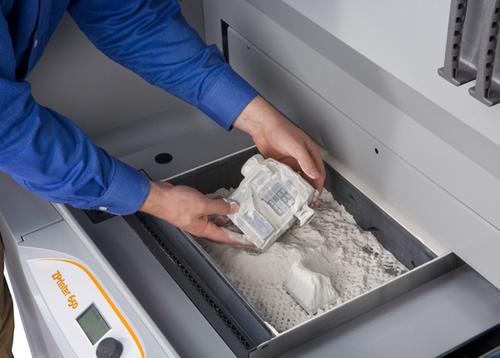
Tri-D 3D printed rocket engine
Posted on 10/15/2013 9:47:20 AM PDT by null and void
UC San Diego students complete successful test of 3D-printed engine
Students from the San Diego chapter of the University of California test-fire a new 3D-printed engine, making UC San Diego the very first university to “additively manufacture” a rocket engine. The engine was printed by GPI Prototype and Manufacturing Services with help from the NASA Marshall Space Flight Center. The engine’s fabrication, from conception to its final test on October 5th, took around 8 months to complete. Already a recipient of the Student Prize award for DIYRockets, Inc’s competition, the engine’s hot-fire test was highly successful and no doubt means exciting new possibilities in the industry’s future.
The UC San Diego students ran their design through a full test of its capabilities after setting up a hot fire mount system. Their engine, named Tri-D, is designed to power the third state of a miniaturized satellite, or NanoSat launcher. Tri-D is fueled by both kerosene and liquid oxygen, capable of 200lbs of thrust. The hot-fire test revealed mach diamonds emitting from the engine, a phenomenon indicating a supersonic gas flow through Tri-D’s nozzle.

Tri-D 3D printed rocket engine
This engine opens vast possibilities for the future of rocket engine design, especially when compared to the more traditional ways of fabricating an engine. 3D printing cuts development costs astronomically: the engine’s total manufacturing cost was only $6,800. Tri-D was printed, designed, and tested by members of UCSD’s Students for the Exploration and Development of Space, representing the Jacobs School of Engineering. The rocket’s hot fire test, shown here, was conducted at the Friends of Amateur Rocketry launch site in the Mojave Desert.
[imbedded video at site]
Financed by NASA, the designers of Tri-D worked closely with the Marshall Space Flight Center during their research into additively manufactured or 3D-printed rocket engines. With NASA’s help, the students designed Tri-D using the greatest features of 3D technology and have no doubt revolutionized the whole of the aerospace industry.
Source Space.com, 3ders.org

Political power grows out of the nozzle of a 3-D Printer.
I assume they printed the negative and used it to make a mold for the castings?
I assume it was directly printed in metal.
In this way manufacturing returns to the US.
cool (or rather hot)
I googled it. It does appear it is possible to print in titanium and other hard alloys. I saw the welds on the prototype and concluded incorrectly you could not print in metals hard enough to take the pressures.
Yeah. What’s up with the weld???
It might have been laser sintered metal printing, but my guess is that they printed in plastic, perhaps PLA, then used the “Lost Wax” process for subsequent casting in metal.
There appear to be weld beads on the base & side tube.
http://www.youtube.com/watch?v=WWVVSZP3Au4
Lost PLA 3D Print to Metal Casting
(Strange looking dude, but interesting, informative video)

Both NASA and Spacex are very interested in this as well.
So 3D printers can TIG weld?
In this case I think the over all part exceeded the build volume and they welded sub-assemblies together.
They must have still had to use old fashion welding equipment. I see a bead near the top.

Excellent!
In related (old) rocket news, this is fascinating.
http://www.uah.edu/student_life/organizations/ASCE/Competition/2001.htm
” Two of our chapter members and some other students on campus recently put this claim to the test by designing, building, and launching the first rocket made from reinforced concrete [launch video http://www.uah.edu/student_life/organizations/ASCE/Competition/rocketlaunch.mpeg]. They used the same mix and reinforcement that we used to construct our “SURVIVOR” [note: “Survivor” was the UAH entry into the 2001 Concrete Canoe Race].
The rocket design team was led by Dr. Marlow Moser of our Mechanical and Aerospace Engineering Department. The people involved in the project are shown in the group photo above. They are (front row L-R) Kevin Pulliam, Shane Smith, Tammy Wenslow, Brian Barnette, April Burgess, chapter member Frances Pitruzzello, Kevin Buch, and Tim Weaver, (back row L-R) Richard Ponder, Dr. Moser, Ricky Campbell, and Daniel Chhitt. Another chapter member, Andre Danson, provided the team with the specifications for our mix design.
According to Ms. Wenslow, “The more we worked with the materials, the more impressed we became.” The vehicle was successfully launched on April 19, 2001. Things went so well that plans have already been made with Alabama A&M University to build and launch a larger prototype that will serve as a sounding rocket to take micro-gravity experiments into space. The project is being supported by a number of Huntsville’s high-tech aerospace companies and federal agencies including NASA’s Marshall Space Flight Center.”
After all, what harm could a rocket engine do?
Disclaimer: Opinions posted on Free Republic are those of the individual posters and do not necessarily represent the opinion of Free Republic or its management. All materials posted herein are protected by copyright law and the exemption for fair use of copyrighted works.